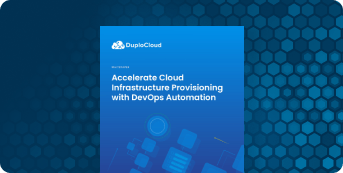These use cases and tools demonstrate the power and efficiency of Infrastructure as Code
Software development has changed. Legacy technology and a lack of cloud services used to mean that physical assets, like servers, required manual provisioning and configuration. Those processes took time, but software development cycles were relatively long, so the investment was acceptable. That was then.
Now, Infrastructure as Code examples like cloud-based environments or on-demand server configurations have evolved with the advent of agile development, greatly speeding up the process of software creation. Suddenly, the time and energy required to provision and configure assets manually sticks out like a sore thumb.
Infrastructure as Code (IaC) solves the problem by creating environments in the cloud. Assets can be configured using automated processes, greatly speeding up the deployment of new servers and the entire process of software development. This saves time and money and creates a more secure and less error-prone software development environment.
The following Infrastructure as Code examples further demonstrate the power of IaC.
Jump to a section…
Infrastructure as Code Examples
Infrastructure as Code Examples
Kloudspot
Kloudspot is a situational awareness and intelligence platform that uses WiFi and BLE-based data to make intelligent spaces and experiences for a range of industries. As one of the first companies to trailblaze this offering, Kloudspot’s platforms were all managed manually on AWS EC2 instances. This proved to be time-consuming to manage and made it difficult to track configuration as Kloudspot grew.
DuploCloud’s DevSecOps-based approach created a more streamlined pipeline for Kloudspot as it spun up new environments and assembled developer tools. This allowed Kloudspot to deploy its new DevOps infrastructure through an automated system and cut both development and service management time by 50%. DuploCloud’s built-in security and incident management also work to automatically ensure compliance for Kloudspot, making the process both more secure and audit-friendly.
These changes helped Kloudspot remain nimble by managing and running multiple workloads at once, helping to ensure it remains a leader in situational awareness and intelligence for years to come.
Rapyder
Rapyder’s client wanted a cloud-based infrastructure that could be provisioned in minutes on multiple clouds. It was looking for production, staging, and QWA environments, as well as database backups.
Rapyder turned to Terraform for provisioning of these environments and automated much of the process to eliminate human error. With Terraform, Rapyder was able to create a cloud-agnostic solution that was easy to implement and dramatically decreased its client’s time to market. Rapyder automated the application deployment process with the open-source GitLab package, making it possible for the client to bring up applications rapidly and automatically. The client can now test its applications and deploy them in the production environment with dramatically decreased downtime.
The end result is not only a happy client, but also one with a shorter time to market that can implement infrastructure on an as-needed basis, saving time and money.
Unisys
Unisys developed a cloud implementation that reduced the costs for California State University’s massive educational IT infrastructure by 33%. The challenge came in bridging systems across 23 campuses serving 485,000 students and around 56,000 faculty and staff.
Unisys implemented a hybrid-cloud infrastructure solution built on AWS and Morpheus Cloud Management Platform, among other technologies. Ansible and Jenkins were used to automate the infrastructure, Delphix data management was used to make data portable, the Securonix SIEM platform was used to increase the system’s security posture, and ServiceNow was used for service management and advanced analytics.
CSU administers one of the largest Oracle/PeopleSoft implementations in the world; Unisys’ solution migrated much of the University’s permanent physical infrastructure to AWS, allowing each campus to cater their online experience to their specific needs rather than adhere to a rigid, legacy experience. In the process, Unisys improved system performance by 30% while usage and demand grew by 40%. It is projected that this solution has saved CSU over $4.5 million in IT infrastructure costs.
Schramm Werkstätten
German premium bedding manufacturer Schramm Werkstätten needed a reliable solution for its IT infrastructure that, above all else, would provide it with secure site ownership. The company turned to the firm Sitewards.
Sitewards’ solution used AWS Elastic Computer Cloud and Ansible to create both testing and production environments, enabling Sitewards to begin deployments within two weeks. The solution also utilized Infrastructure as Code to lessen downtime due to unanticipated behavior in the production environment. This can be caused by a number of factors, including missing third-party services, unanticipated demand, unexpected user behaviors, or intentional abuse of the system. Sitewards solved for these issues by implementing instrumentation using Prometheus, OSQuery, and Falco. The system is now queryable in times of stress and has minimized downtime.
According to Sitewards, this Infrastructure as Code example required a significant initial expense but has paid for itself over time, minimizing the amount spent on updates and maintenance. The client has moved away from reliance on third parties and now utilizes an IaC deployment that is more secure and less labor and cost-intensive.
To see more examples and learn how today's companies are utilizing low-code / no-code platforms to deploy cloud applications ten times faster, read our free report:

Infrastructure as Code Tools
The advent of IaC has led to the introduction of a variety of new tools. Here are some of the most popular and promising.
DuploCloud
DuploCloud’s unique offering lets clients build services to scale on a no-code/low-code software platform. To do so we automatically create and provision all the necessary Infrastructure as Code, complete with best practices for security, availability, and compliance. Meanwhile, built-in DevSecOps expertise maximizes uptime even as you continue to refine and optimize your service.
Terraform
Terraform is platform-agnostic, and its HCL code is easy to read, making it another great tool for beginners (although its sheer adaptability might require some acclimatization first). This IaC tool can be used across a variety of cloud platforms, like AWS, Azure, GCP, and Oracle. It specializes in managing infrastructure for complex distributed applications.
Ansible
Ansible is an open-source suite of software tools that allow for the implementation of IaC. Created by Red Hat, Ansible is first and foremost an automation tool specializing in provisioning. It focuses less on managing established cloud environments and more on full life-cycle support for organizations.
AWS CloudFormation
AWS CloudFormation is an AWS-native solution for configuring and provisioning cloud environments. It is a powerful solution for users of AWS that allows for automated setup of platform-specific resources. If you are committed to AWS, and are deploying multiple environments, CloudFormation is hard to beat.
Azure Resource Templates
Azure Resource Templates is an IaC tool native to Microsoft's Azure Resource Management for the Azure cloud. ARM templates allow you to integrate deeply with other Azure services and rapidly provision Azure resources. Like AWS CloudFormation, it’s a substantial boon for those working with its specific cloud service.
Trying to find the best way to integrate Infrastructure as Code with your next project? Reach out to DuploCloud today and see how we can help.









